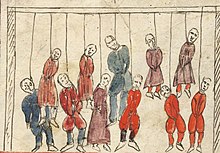This article has multiple issues. Please help improve it or discuss these issues on the talk page. (Learn how and when to remove these template messages)
|
The sons of Haman were ten men mentioned by name in the biblical book of Esther who were killed on the 13th of Adar and hanged the following day, the 14th of Adar.[1][2]


The names of Haman's ten sons have been variously interpreted in terms of their possible Iranian forms. Some of the names can reasonably be considered to be Iranian, but it is difficult to notice a clear pattern of Iranian forms in them.[3] The names given in the biblical text are:
- Parsandata: first son of Haman to be mentioned. In the 12th century, the name gained a literary meaning. It was then separated into the words "parsan" (= "interpreter") and "data" (= "law"), and was used with reference to Rashi, who has since been cited by that name.[4]
- Dalphon: the second of Haman's ten sons. His name in the Septuagint is Δελφών.[5]
- Aspatha: third son to be mentioned, whose name in Hebrew is אַסְפָּֽתָא[6]
- Poratha: the fourth son of Haman to be mentioned. Its name in Hebrew is פּוֹרָתָא, probably a Persian name, the meaning of which may be "very bestowed".[7]
- Adalia: the meaning of his name is unknown; in Hebrew it is אֲדַלְיָ֖א[8]
- Aridata:
- Parmasta:
- Arisai:
- Aridai:
- Vaizata: The name clearly appears to derive from ancient Iranian *Vahya-zāta- “born of the best”.[3]
According to the Talmud, Haman had many other sons. Talmudic scholars disagreed on the number of Haman's sons; according to one account, there were thirty: ten died, ten were hanged, and ten became beggars. According to the rabbis, the beggars numbered seventy; according to Rami bar Abi, there were a total of two hundred and eight sons in all.[2] Rashi explains that those ten who were killed and hanged are the ones who wrote hateful words about the Jews and Jerusalem.[citation needed] The Hebrew text displays peculiarities. It can be noted that the names of Haman's ten sons are written vertically, one below the other, in a column; according to Jewish tradition, this indicates that they were hanged one above the other on an extremely tall gallows.[9]
R. Mordechai Sasson explains that Haman symbolizes the Yetzer Harah (evil inclination), and his ten sons allude to his ten traits of bad character. Their deaths represent the elimination of these evil traits when defeated by the Yetzer Tov (good inclination). He explains the meaning of each name and how each corresponds to a type of evil.[10]
References
edit- ^ "Ester 9 — BIBLIOTECA ON-LINE da Torre de Vigia". wol.jw.org. Retrieved 2021-07-07.
- ^ a b "HAMAN THE AGAGITE - JewishEncyclopedia.com". www.jewishencyclopedia.com. Retrieved 2021-07-07.
- ^ a b Shaul Shaked, “HAMAN,” Encyclopaedia Iranica , XI / 6, p. 629, available online at http://www.iranicaonline.org/articles/haman (accessed on July 7, 2021).
- ^ "PARSHANDATHA - JewishEncyclopedia.com". www.jewishencyclopedia.com. Retrieved 2021-07-07.
- ^ "DALPHON - JewishEncyclopedia.com". www.jewishencyclopedia.com. Retrieved 2021-07-07.
- ^ "Aspatha - Encyclopedia of The Bible - Bible Gateway". www.biblegateway.com. Retrieved 2021-07-09.
- ^ "Poratha from the McClintock and Strong Biblical Cyclopedia". McClintock and Strong Biblical Cyclopedia Online. Retrieved 2021-07-07.
- ^ "Adalia - Encyclopedia of The Bible - Bible Gateway". www.biblegateway.com. Retrieved 2021-07-09.
- ^ "Esther 9:7 Commentaries: and Parshandatha, Dalphon, Aspatha,". biblehub.com. Retrieved 2021-07-09.
- ^ "megillat esther - What meaning do the names of the ten sons of Haman have?". Mi Yodeya. Retrieved 2021-07-07.